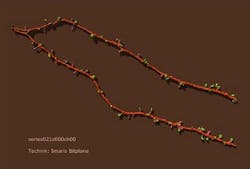Software-driven fluorescence microscopy visualizes neuron activity
Seeking to understand how nerve cells contact each other to transmit information and which proteins and mechanisms control the formation and function of these synaptic contacts, researchers at the University of Münster (Münster, Germany) have shown that the loss of the protein neurobeachin (Nbea) not only disrupts signaling within the neuron, but also leads to reduced numbers of spines (actin-rich dendritic protrusions) and the mislocalization of another common spine protein, synaptopodin. The team accomplished this using fluorescence microscopy driven by image analysis software (Bitplane's Imaris software).
Led by Professor Markus Missler, Katharina Niesmann, Ph.D., used cultured primary nerve cells from the hippocampus of mouse brains. Then, multicolor labeling followed by observation under epifluorescence and confocal light microscopy enabled the team to study the differentiation of synapses between these cells and observe the effect of Nbea.
The research results have been published in Nature Communications; for more information, please visit http://www.nature.com/ncomms/journal/v2/n11/full/ncomms1565.html.
-----
Follow us on Twitter, 'like' us on Facebook, and join our group on LinkedIn
Subscribe now to BioOptics World magazine; it's free!

